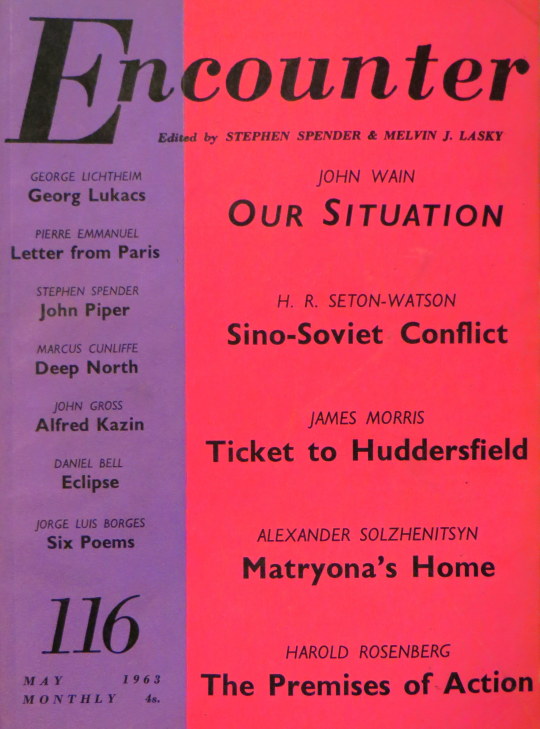I want to believe the internet is a nice utopia of thought and freedom for people, so this is really why I type up obscure interviews and articles on people for this blog. So far this has been limited to Paul Nash, Frans Masereel and Eric Ravilious but I have many others earmarked from niche publications that I own that seam far too expensive to buy. I hope they are of interest to you all and here is another on John Piper, at this time aged 60. It has a long introduction by Spender but I think it’s nice to read Piper expressing himself about his work, mid career.
A Talk with John Piper by Stephen Spender.
From Encounter #116. May 1963.
When I first knew John Piper, in the ‘thirties, he was one of several painters (Ben Nicholson was another) who resisted the turning of Coldstream, Moynihan, Pasmore, and the Euston Road painters towards portraits, landscapes and still lifes. These were artists who, a bit fastidiously, pushed representation towards a frontier where it began to turn into near-abstract drizzly lines (Coldstream), pure colour (Pasmore), rich lumpiness (Moynihan).
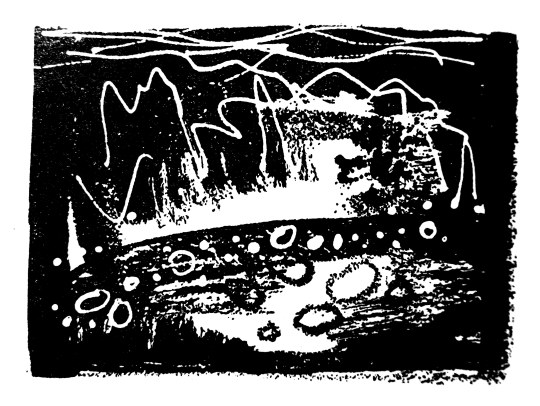
John Piper has a lean and hungry look and a lank cheek, like Caesar’s idea of Cassius, and was perhaps also a bit quixotic, as though he might suddenly appear in armour. Although he supported all the virtuous left-wing causes and conscientiously attended every director’s meeting of the Group Theatre, he went on painting abstracts about the size of windmills. During the war he became a War Artist, a position for which his love of architecture, ruins, and an atmosphere of drama admirably qualified him. His paintings of burning churches and barns form, with Moore’s shelter drawings, Sutherland’s iron foundries, the best part of the artistic record of the war.
Before the was, as though to prepare himself for events, Piper has started doing collages of Welsh villages and landscapes. He also did the set for the Group Theatre’s production of ‘Trial of a Judge’. After the war he established a new reputation as a topographical artist, with his series of water colours of Windsor Castle, Renishaw, and other famous houses. He continued with Welsh landscapes – pen-and-ink scratched,with texture like that of cracks in slate, slopes of shale, enclosed in golden washes.
He went on working in the theatre (doing the sets among others for Billy Budd) and painting abstracts. Recently he has done a whole series of oils and water colours of Venice and Rome. Piper is in fact an extremely prolific painter, branching out into many different styles and activities, but at the same time with a very marked consistency which makes a Piper, whether it is a water colour two inches by four, or a stained-glass window the size of a battleship, immediately recognisable. All the same, his work is (it seems to me) very uneven on account of the tension in his nature between the almost oriental richness of some of his water colours, and the extreme dryness which shows in many of his oils, even when they are theatrical and garish. His achievement is absolutely honourable: a fusion of a life-long search for a contemporary idiom with a passion for tradition. He is one of the few English artists whose reputation is more likely to increase than to decline.
To-day tape-recorders have had an effect on interviewing like that of photography on drawing. A printed interview appears a transcript a tape-recording, a bad imitation of one, or a fictitious intervention of the interviewer. Since I hate tapes, and anyway do not know how to use them, I will leave my notes (made in the course of a day spent at the delightful stone farmhouse in a sheltered valley near Henley, where the Pipers live) much as they were written.
Some of them are taken from conversation, some of them were written for me by John Piper before I arrived. It is John Piper speaking:
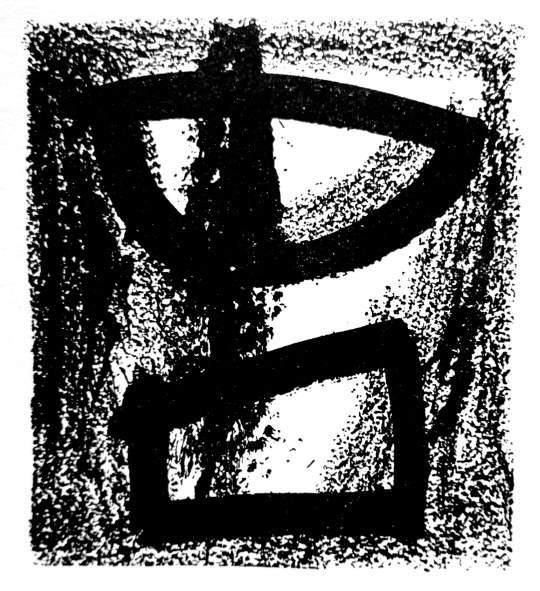
The Eye.
There isn’t a difference between “abstract” and “topographical” in the sense that one might consider “abstract” as purr invention, and “topographical” as imitation. The reason for this is that nothing comes out of a visual consciousness that has not already been received by the eye. All visual invention is the result of visual experience and observation. Everything is drawn out of the stock-pot of visual impressions. Abstraction is a way of inventing variations on the visual experiences one has had, but these may not prove enough to make a decent painter. There have been very few abstract masterpieces apart from those by Mondrian and Rothko. So when one looked into one’s heart and asked “Where do we go from here?” one looked at one’s own nature. I found I was English and Romantic, so I looked at Cotman, Turner, Blake, Palmer and painters in that in that tradition and tried to draw the things I seemed born to love.
Topography.
Topography is a branch of Romantic art, and it is also a branch of particularisation. For Romantic art consists in seeing the wing of a bird – a tower – a hop field – and interpreting all nature through the particular. Topography at its best is the interpretation of the world as a vision of the place. The best topographical paintings have spirit of the place in the time, not just the representation of the place, as Cotman expresses the atmosphere of places in Norfolk in the 19th century. Giorgione’s La Tempesta is the epitome of every virtue topographical art should have.
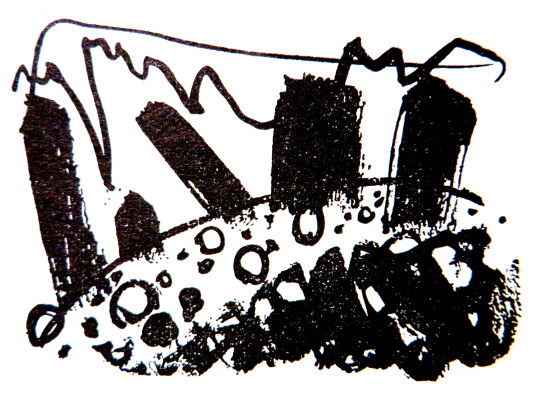
Photography.
Photography us useful because it makes one’s vision ridiculous. It proves that what one has seen is in literal fact a cliché. I never take photographs of anything I draw, unless I think the photographs may be useful as something to react against.
Abstraction.
Abstraction is much more difficult for English artists than some of them realise. By habit, certainly, and probably by temperament m most English people are literary before they are visual – they have to go through some process, some ritual almost, before they see at naturally and simple. Everything is wrapped in a known idea of itself, a concept. And then, when they do begin to see a thing directly, more or less for what it is, half the time they want to reinterpret the experience in words. Intensity! Intensity is all – but the intensity is made of something, experiences, love, hate, fears: and the natural progress for an Englishman is to explain himself in words before he sings or scribbles.
Crafts.
Nobody can possibly have more than two or three original ideas to bring to any craft, without renewing himself by working with his hands all by himself in the studio. The rest is tinkering, improving, tidying, untidying, and doing variations. People think that they can be original stage designers, and can go on being original indefinitely. All they’re doing is turning round on the same spot and facing different ways, using the same two or three little ideas they had when they were twenty: unless, of course, stage designing is simply another form of interior decorating, which it is often thought to be by the public and producers, and especially by music critics, who like everything beige and grey so not to interfere with the music. As for stained glass, there had not been any new ideas in that – not even little ones – for 200 years until Léger and Matisse came along (preceded by a herald or two like Miss Geddes and Miss Hone).
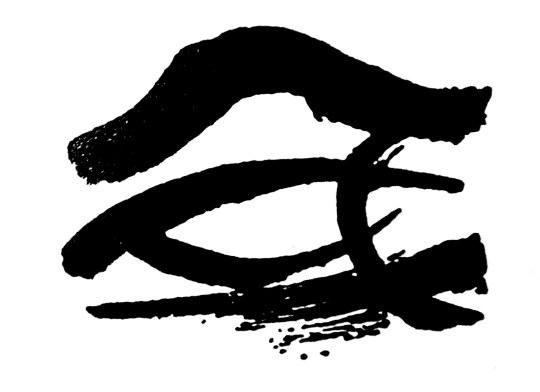
Stained Glass and Real Painting.
The bogey of stained glass is its recent history, like the bogey of English painting fifty years ago. You have to steer through all the crafty “traditions.” But in fact the proper rules of the craft (as opposed to the acquired traditions) help a lot by providing an artificial discipline, so that you don’t have to invent one of your own. That’s the horror of crafts. In other words, the limitations of the medium itself, the craft, make half the troublesome decisions for you before you start, and set the pace, and then the craftsman, if he is a good craftsman, takes the strain of a lot more decisions – tensions – all those that have to be made from minute to minute during the work. It is a rest, really, for the designer, except for the enormous area of a window he has to cover. First-class interpretive craftsmen like Patrick Reyntiens or like Charles Bravery, the scenic painters, take nearly all the strain anyway.
No, what is really difficult is to create a masterpiece on paper or canvas all by yourself in the studio with no artificial discipline of the craft that can offer ingenious solutions, no outside help at all. That’s what’s difficult. Loves, hates, fears: those are what painting is about. It is very difficult to paint love and hate without bringing in the things they are about. Abstraction can be achieved, and complete abstraction, without total loss of richness and intensity. I do belie that. Only, as I say, it is much more difficult than most people make out. People pretend that they’re born into it these days. They aren’t, any more than Mondrian was. He achieved it though a long, lonely sweat, like anyone else.
Twenty-five years ago I painted purely abstract paintings for five years, mixed with some collages (which we weren’t allowed to call collages by the galleries, because they said the name suggested that they might come unstuck). – which were done, more or less, from nature. I did actually go out with a big sketch book full of scraps of grey and brown-coloured paper, and a pair of scissors and a bottle of gum or glue. I tried to keep these going side by side with the oils, which were purely abstract-schematic arrangements of shapes and colours I wanted, even then, some of the natural energy and fecundity of nature to get into them, even at second hand. It got into Mondrian through his early works, and through his post-cubist pictures. All this time I had a feeling that-while one was learning a great deal (by putting one colour in a positive shape against others) about the mutual reactions of positive colours and positive shapes, which is the right stuff – at the same time one felt that the things one was producing lacked the richness, the fullness, and the ripeness of life: which, of course, they did, because one wasn’t rich, full or ripe enough; and still one isn’t but you can’t go on waiting till you die.
